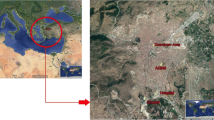Abstract
Hot mix asphalt plants are characterized as air polluting industries. Their pollution potential and impact on the ambient air quality were assessed in the present work. The emission monitoring was conducted in respect of particulate matter and the gaseous pollutants at fifteen representative plants located in different zones of India. The stack emission monitoring results of batch mix plants had shown the concentration of particulate matter varying from 99 to 182 mg/Nm3 with an average of 128 mg/Nm3. In case of drum mix plants the average particulate matter concentration was observed as 282 mg/Nm3. The sulphur dioxide emission results were observed as 114 to 257 mg/Nm3 and 115 to 217 mg/Nm3 for the batch mix plants and the drum mix plants, respectively. The nitrogen oxide emissions were noted as 77 to 209 mg/Nm3 for the batch mix plants and 79 to 215 mg/Nm3 for the drum mix plants. The monitoring results had shown that the batch mix plants are less polluting than the drum mix plants in terms of particulate matter emissions. The impacts of emissions from the hot mix plants were assessed by measuring the ambient air quality at upwind and downwind locations in respect of PM10, PM2.5, SO2, NO2 and CO. Based on the air quality monitoring results, an air quality index was calculated using the linear segmented principle for a given location. It was observed that the emissions from the hot mix plants impact 2 to 94% deterioration in the ambient air quality. The deterioration in air quality is mainly attributed to the fugitive emissions.




Similar content being viewed by others
Data Availability
Data presented in the article are based on field studies and the emission monitoring conducted at fifteen HMAP sites. The analysis and interpretation of data are based on author’s experience and the published literatures.
References
Aman, G.G. (2019). Community exposure to particulate matter and its impact for students and residents near a construction asphalt plant: A case study. Theses (dissertation), University of Nevada, Las Vegas. https://doi.org/10.34917/18608652
APHA. (1977). Standard methods of air sampling and analysis, 2nd Ed., APHA Inner Society, Committee, 18th Street NW, Washington DC20036.
Bowers, B.F., & Powell, R.B. (2021). Use of a hot-mix asphalt plant to produce a cold central plant recycled mix: Production method and performance. Transportation Research Record: Journal of the Transport Research Board. https://doi.org/10.1177/03611981211017904
CPCB. (2012). Guidelines on methodologies for source emission monitoring, no. LATS/80/2013–14. Central Pollution Control Board, Delhi, India.
CPCB. (2013). Guidelines for the measurement of ambient air pollutants, Vol. I, no. NAAQMS/36/2012–13. Central Pollution Control Board, Delhi, India. report_epm_NAAQMS .pdf (mahenvis.nic.in)
CPCB. (2015). National air quality index, no. CUPS/82/2014–15. Central Pollution Control Board, Delhi, India. https://app.cpcbccr.com/ccr_docs/FINAL-REPORT_AQI_.pdf
EPA. (2000). Hot mix asphalt emission assessment report, no. EPA-454/R-00–019. United States Environment Protection Agency, Research Triangle Park, NC 27711.
Franzitta, V., Longo, S., Sollazzo, G., Cellura, M., & Celauro, C. (2020). Primary data collection and environmental/energy audit of hot mix asphalt production. Energies, 13, 2045–2046. https://doi.org/10.3390/en13082045
Hirato, T., Murayama, M., & Sasaki, H. (2014). Development of high stability asphalt concrete with hybrid binder. Journal of Traffic and Transportation Engineering (english Version)., 1(6), 424–431. https://doi.org/10.1016/S2095-7564(15)30292-0
IRC. (2010). Guidelines of selection, operation and maintenance of bituminous hot mix plant 1st rev. National Road Congress, New Delhi, India.
Jhu, J., Birgisson, B., & Kringos, N. (2014). Polymer modification of bitumen: Advances and challenges. European Polymer Journal., 54, 18–38. https://doi.org/10.1016/j.eurpolymj.2014.02.005
Karacasu, M., Hattatoglu, F., Hinislioglu, S., & Murat, Y. S. (2014). Use of asphalt plant residue in hot mix plant. International Journal of Global Warming., 6(2/3), 127–129. https://doi.org/10.1504/IJGW.2014.061003
Kinsey, J. S. (1976). An evaluation of control systems and mass emission rates from dryer-drum hot asphalt plants. Journal of the Air Pollution Control Association., 26(12), 1163–1165. https://doi.org/10.1080/00022470.1976.10470376
Kumar, N., & Rajakumara H.N. (2016). Study of using waste rubber tires in construction of bituminous road. International Journal of Scientific and Engineering Research, 7(5), 23–27. https://www.ijser.org/researchpaper/Study-of-Using-Waste-Rubber-Ty…
Mahalaxmi, M., Priyankapraash, S., Shalini, T., et al. (2014). Utilization of waste plastic in bitumen. International Journal of Engineering Research and Technology., 3(2), 2720–2727.
Mamat, P., & Bassin J.K. (2010). Analysis of ambient air quality using air quality index—A case study. International Journal of Advanced Engineering Technology. 1(2), 106–114. www.technicaljournalsonline.com/ijeat/VOL I/IJAET VOL I ISSUE II JU… ·
UN. (2015). Sustainable development goals, Sustainable development goals 12: Responsible consumption and production, Sustainable Development, Department of Economic and Social Affairs, United Nations. THE 17 GOALS | Sustainable Development (un.org).
Wang, C., Li, Q., Wang, K. C. P., et al. (2017). Modified hot mix asphalt mixtures. Advances in Materials Science and Engineering. https://doi.org/10.1155/2017/2506381
Wu, P. (2015). Study on quality of hot mix plant recycling mixture under influence of RAP performance. In abstract of 2nd International Conference on Green Materials and Environmental Engineering, Changan University, China. https://doi.org/10.2991/gmee-15.2015.1
Zaumanis, M., Mallick, R. B., & Frank, R. (2016). 100% hot mix recycling: Challenges and benefits. Transport Research Procedia., 14, 3493–3502. https://doi.org/10.1016/j.trpro.2016.05.315
Acknowledgements
The author sincerely appreciates the contributions of Deepa Choudhary, Ouiman Souel, Yogendra Prakash and K.D. Bhardwaj for accomplishing the study.
Author information
Authors and Affiliations
Corresponding author
Ethics declarations
Competing Interests
The author declares no competing interests.
Additional information
Publisher's Note
Springer Nature remains neutral with regard to jurisdictional claims in published maps and institutional affiliations.
Rights and permissions
Springer Nature or its licensor (e.g. a society or other partner) holds exclusive rights to this article under a publishing agreement with the author(s) or other rightsholder(s); author self-archiving of the accepted manuscript version of this article is solely governed by the terms of such publishing agreement and applicable law.
About this article
Cite this article
Kharat, D.S. Emissions from Hot Mix Asphalt Plants and their Impact on Ambient Air Quality. Water Air Soil Pollut 233, 464 (2022). https://doi.org/10.1007/s11270-022-05950-w
Received:
Accepted:
Published:
DOI: https://doi.org/10.1007/s11270-022-05950-w




